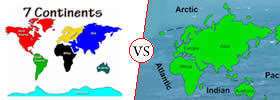English as a Foreign Language
Kid vs Child
|
The word ‘kid’ was originally not even used to refer to human children, but meant a baby goat, but in the 16th century the word was adapted to even include human babies and children. The word ‘child’ comes... |
ie vs eg
|
Both ‘ie’ and ‘eg’ are short forms, which are used to imply something else. ‘ie’ stands for ‘id est’ which is Latin, and translates into ‘in other words’ or ‘that is’ or ‘that is to say’. ‘eg’ stands for ‘... |
To vs For
|
To is primarily used for destination, time, distance, comparison, giving (verb), and motive or reason with a verb. For is primarily used for benefits, period of time, schedule, opinion, task, motive or reason... |
Like and As
|
The primary difference between ‘like’ and ‘as’ is the fact that ‘like’ is used to make a direct comparison, whereas ‘as’ is used to link two phrases together which are related in some way or manner. Another... |
And vs Or
|
Both ‘and’ and ‘or’ are conjunctions and hence are often used in a similar context. ‘And’ is a type of coordinating conjunction and is commonly used to indicate a dependent relationship. Here, the two clauses... |













